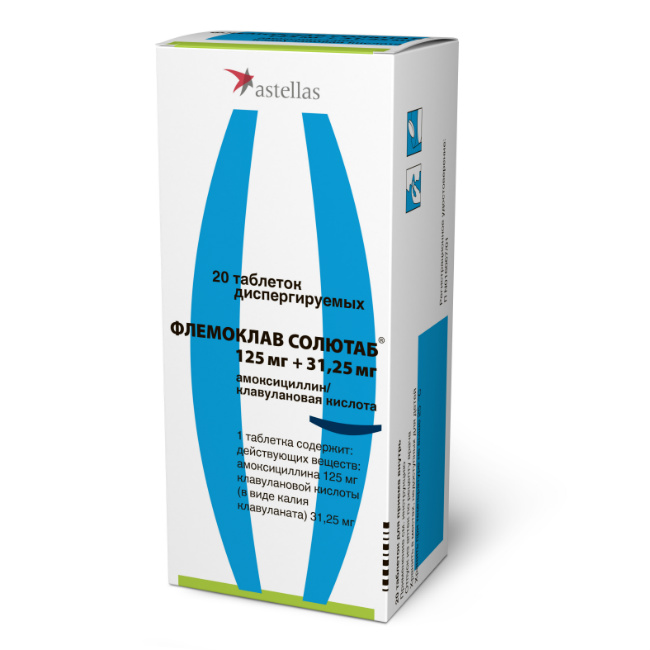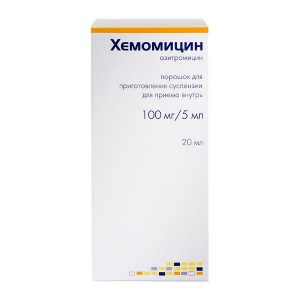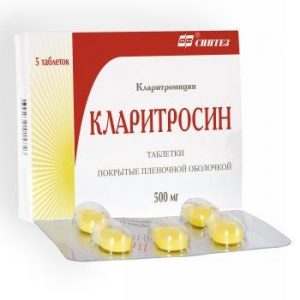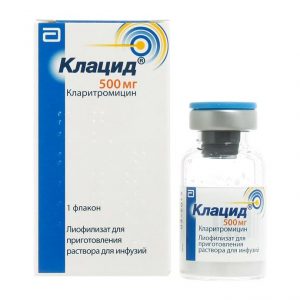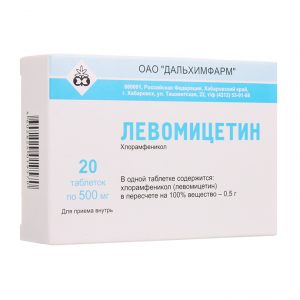Description
Latin name
Flemoslav Solutab
Release form
dispersible tablets
packaging 20 pcs
Pharmacological action
Broad-spectrum penicillin group antibiotic contains semisynthetic penicillin amoxicillin and b-lactamase clavulanic acid inhibitor.
Amoxicillin is bactericidal, inhibits cell wall synthesis. Clavulanic acid inhibits most clinically significant b-lactamases (types II, III, IV, and V according to the Richmond-Sykes classification). Inactive against type I b-lactamases produced by Enterobacter spp., Pseudomonas aeruginosa, Serratia spp., Acinetobacter spp. Clavulanic acid forms a stable inactivated complex with these enzymes, which prevents the enzymatic degradation of amoxicillin under the influence of b-lactamases and expands its spectrum of action.
Flemoklav Solutab is active against both amoxicillin-sensitive strains and strains producing b-lactamases.
Flemoklav Solutab is active against aerobic gram-positive bacteria: Streptococcus pneumoniae, Streptococcus viridans, Streptococcus pyogenes, Staphylococcus aureus (including strains, producing b-lactamases), Staphylococcus epidermidis (including strains producing b-lactamases), Enterococcus faecalis, Corynebacterium spp., Bacillus anthracis, Listeria monocytogenes anaerobic gram-positive bacteria: Clostridium spp., Peptocpppppt. aerobic gram-negative bacteria: Escherichia coli, Klebsiella spp., Proteus mirabilis, Proteus vulgaris, Yersinia enterocolitica, Salmonella spp., Shigella spp., Haemophilus influenzae, Haemophilus ducreyi, Neisseria gonorrhoeae bacteria , Bordetella pertussis, Gardnerella vaginalis, Brucella spp., Branhamella catarralis, Pasteurela multocida, Campylobacter jejuni, Vibrio cholerae, Moraxella catarrhalis, Helicobacter pylori anaerobic gram-negative bacteria: Bacteroides spp., Including Bacteroides fragilis (including b-lactamase producing strains).
Indications
Infectious and inflammatory diseases caused by microorganisms sensitive to the drug: – upper respiratory tract infections and ENT organs (including otitis media, sinusitis, tonsillitis, pharyngitis)
– lower respiratory tract infections (chronic bronchitis and its aggravation community-acquired pneumonia)
– infections of the skin and soft tissues
– infections of the kidneys and urinary tract
– infections of the genital organs.
Contraindications
– impaired renal function
– urosepsis and infection of the renal parenchyma
– impaired liver function
– pregnancy
– breastfeeding
– childhood and adolescence up to 18 years of age, lactose freement, – lactosis , glucose-galactose malabsorption
– increased sensitivity to furazidine, other components of the drug
– increased sensitivity to nitrofuran derivatives.
With caution, the drug should be prescribed for anemia, lung diseases (especially in patients over 65), diseases of the nervous system, diabetes mellitus, porphyria, deficiency of glucose-6-phosphate dehydrogenase, group B vitamins and folic acid.biotics, such as penicillins and cephalosporins
– hypersensitivity to amoxicillin, clavulanic acid and other components of the drug.
With caution, a drug should be prescribed for severe liver failure, chronic renal failure, gastrointestinal diseases (including a history of penicillin colitis).
Use during pregnancy and lactation
When using Flemoklav Solutab during pregnancy, its negative effect on the fetus or newborn was not noted. The use of the drug in the II and III trimester of pregnancy is considered safe. In the first trimester of pregnancy, Flemoklav Solutab should be used with caution.
Amoxicillin is excreted in breast milk. There is no data on the excretion of clavulanic acid with breast milk. There were no adverse effects on the baby during breastfeeding while taking Flemoklav Solutab.
Composition
1 tab. contains amoxicillin trihydrate 125 mg,
potassium clavulanate 31.25 mg.
Dosage and administration
Adults and children over 12 years of age (weighing more than 40 kg) are prescribed 1 tab. 500/125 mg 3 times / day. In severe, chronic, recurrent infections, this dose can be doubled.
For children aged 2 to 12 years (weighing approximately 13-37 kg), the daily dose is 20-30 mg of amoxicillin and 5-7.5 mg of clavulanic acid per kg of body weight. On average, this amounts to a dose of 125 / 31.25 mg 3 times / day for children aged 2 to 7 years (body weight about 13-25 kg) and 250 / 62.5 mg 3 times / day for children aged 7 to 12 years ( body weight about 25-37 kg). In severe infections, this dose can be doubled. The maximum daily dose is 60 mg of amoxicillin and 15 mg of clavulanic acid per kg of body weight.
The duration of treatment depends on the severity of the infection and is 5-14 days. Treatment should not be continued for more than 14 days without a second medical examination, as the risk of side effects increases when taking the drug for more than 14 days.
Drug interaction
When used simultaneously with Flemoklav Solutab antacids, glucosamine, laxatives, aminoglycosides slow down and reduce the absorption of the active components of the drug ascorbic acid – increases.
When used simultaneously with Flemoklav Solutab, bactericidal antibiotics (including aminoglycosides, cephalosporins, cycloserine, vancomycin, rifampicin) exhibit a synergistic interaction between bacteriostatic drugs (macrolides, chloramphenicol, lincosamides, tetracyclines, sulfanilamides).
With the simultaneous use of Flemoklav Solutab increases the effectiveness of indirect anticoagulants by suppressing intestinal microflora, reducing the synthesis of vitamin K and prothrombin index.
Flemoklav Solutab with simultaneous use reduces the effectiveness of oral contraceptives, drugs, during the metabolism of which PABA, ethinyl estradiol is formed (risk of acyclic bleeding).
Diuretics, allopurinol, phenylbutazone, NSAIDs and other drugs that block tubular secretion, with simultaneous use with Flemoklav Solutab increase the concentration of amoxicillin (clavulanic acid is excreted mainly by glomerular filtration).
The simultaneous use of Flemoklav Solutab with allopurinol increases the risk of skin rash.
The simultaneous use of amoxicillin and digoxin can lead to an increase in the concentration of digoxin in blood plasma.
Overdose
Symptoms: nausea, vomiting, diarrhea with possible impaired water and electrolyte balance.
Treatment: appoint activated charcoal, it is necessary to maintain water and electrolyte balance, conduct symptomatic therapy, with convulsions appoint diazepam, with renal insufficiency severe hemodialysis.
Storage conditions
The product should be stored out of the reach of children at temperatures up to 25 ° C.
Shelf life
3 years.
dosage form
lozenges
Prescribed
Prescribed
For children prescribed by a doctor Adults prescribed by a doctor
Astellas Pharma Europe BV, Netherlands
